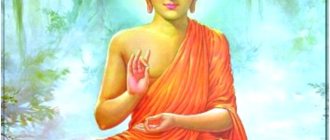The main question of religion that we deal with in the West is the question of the existence of a Creator God who created heaven and earth. Was the Buddha an atheist or an agnostic in this regard, did he recognize the existence of a Supreme Being or God?
The Buddha was a Tathagata, literally “the mouthpiece of Truth,” and had a comprehensive and comprehensive awareness of all dimensions of existence. As a rule, however, he preferred not to speak on metaphysical topics not related to the search for the path to liberation, although in some Sutras he did speak about the origin of the world, the human race and the like. And to understand the meaning of his statements, one should turn to traditional Buddhist cosmology.
Chief god of Buddhism
Beings who are reborn in the World of Desires or Kamadhatu have either a gross material body, like man and animals, or a body of subtle matter, like the Devas, Asuras, Pretas and hell beings. Above the World of Desires are the highest planes of purely mental existence, inhabited by beings whose bodies are woven from light. The totality of these higher levels is called Rupadhatu, the world or dimension of pure forms.
The sentient beings who inhabit these higher planes of existence are free from all gross sensual desires and are surrounded by vast auras of light. They are absorbed in their abstract meditations and remain in this state of existence for an extremely long time, by human standards. These highest gods are not called Devas, but Brahmas, “pure ones.”
In Buddhist usage, Brahma is a generic term for some type of divine existence, and not a proper name for a separate Creator God, as in Hinduism. Like the existence of Devas, the existence of Brahmas is determined by personal karma, although in this case it is called indefinite karma (Sanskrit aninjya-karma). Thus, although on the higher mental planes we may exist as Brahma for a period of time measurable only in cosmic units, yet, when the karma we have accumulated is inevitably exhausted, we find ourselves born in some other place.
Moreover, although many religions consider one of the Brahmas to be the omniscient Creator God, the Brahmas, like the Devas, are unenlightened beings. Even though they have the greatest wisdom and great powers of clairvoyance and foresight, they are still not omniscient, since they do not understand the true nature of existence. In this respect, Buddha is infinitely superior to all the gods of traditional religions, for all these gods are too much of this world, laukika devas - deities belonging to cyclic existence.
For example, according to ancient Indian beliefs, Indra was the king of the gods or Devas and led their glorious army in the battle against the Asuras who ruled the nations. In addition, Indra could cause storms to bring life-giving rain to the fields of the righteous who observed the laws of morality and society. But he could also burst out in anger, striking down apostates and wicked people with lightning. Or, again, there was Brahma, called Prajapati, that is, “Progenitor,” who supposedly ruled our world as its creator and lawgiver, bestower of the Vedas.
Such mythological beliefs existed in India at the time of the Buddha, and our Western religious ideas are based on approximately the same myths. But in the previous Kalpas there had been a long line of Indras, each of whom reigned, seated for a time in the magnificent palace of Vyjayanti on the top of Mount Meru in the center of the world. And similarly, there was an endless chain of Brahma Prajapatis, each of whom considered himself to be the God who created the universe. But since they are conditioned and therefore limited and do not have the fullness of knowledge, Buddhists seek refuge not in them, but in the principle of enlightenment, in the Buddha. When Shakyamuni achieved enlightenment under the Bodhi tree and became the Buddha, the first who came to him to pay their respects and request him to teach the Dharma for the benefit of all beings were the gods Indra and Brahma.
Development of the doctrine
Having appeared in Ancient India and spreading throughout the East, Buddhist thought has witnessed many events throughout its existence and endured various vicissitudes of history: the emergence of Hinduism in India, the raids of the Aryans, oppression by Muslims, the establishment of the powerful Mughal Empire, modern times with its globalization.
However, the dharma continues to spread throughout the world - today there are about 500 million adherents.
This is mainly, of course, the south, southeast Asia and the Far Eastern regions: Thai, Bhutanese, Vietnamese, Chinese (especially Tibetan), Japanese, Cambodian, Laotian, Korean, Sri Lankan, Myanmar, Nepalese, Mongolian territories.
In India, which
is the birthplace of Buddhism, with the spread of Hinduism, the teaching lost its significance - here it is professed by less than one percent of the total population.
Some national republics in Russia also traditionally adhere to Buddhist views: Kalmykia, Tuva, Buryatia, and part of the Altai regions. Bypassing them, thought moves deeper and deeper to the West: to Moscow, St. Petersburg, to European countries and to the American continent.
Buddhist version of the creation of the world
The Buddhist version of the origin of the world is set out in the Sutras. Answering questions from his students, the Buddha explained that humanity inhabiting planet Earth previously lived in another planetary system. Long ago, when the sun of that world went supernova and the planet died in the flames of the explosion, most of its inhabitants, through the ardent practice of Dharma for ten thousand years, were reborn on one of the highest planes of the World of Forms or Rupadhatu, a plane of existence called Abhasvara or "pure light" Here they enjoyed happiness and bliss beyond the reach of human understanding for countless eons. Then, when the enormous karma they had accumulated in the past ripened, our solar system began to form, and some of their number were reborn on the lower planes of Rupadhatu near the nascent Earth.
The plane of existence in which they find themselves is called Brahmaloka. Seeing the formation of the solar system beneath them, the first of these creatures, who were to wake up in a new incarnation, exclaimed with satisfaction: “I am the Creator!” It began to consider itself the actual creator of the surrounding universe, because it did not remember where it came from, and it had no parents.
In reality, however, the manifestation of this universe was due to the collective karma of all these beings, and his own manifestation, which was one of the options for birth into the world of illusion, was due to the enormous merits of the karma he had accumulated, which had matured by that time due to the presence of the necessary secondary conditions.
However, he persisted in his delusion, considering himself the real Creator of the universe, since he was born in the emerging solar system first and saw that there was no one here before him. But this faith, being an initial denial of his true origin, only limited and darkened him, so that he fell victim to his own pride. This was the first manifestation in our universe of ego or belief in the reality of the existence of a “self.” And although he considered himself self-created, in reality his appearance at the center of our world was a consequence of his favorable karma. And since he was the first of the Brahmas who were to be born outside Abhasvara, he began to be called Mahabrahma or God.
Having spent many eons since the beginning of the solar system in solitary splendor, he began to experience loneliness and thought that it would be nice if there were someone else capable of recognizing his power. And at that very moment, because their karma had ripened, many other beings from Abhasvara were born as Brahmas in Brahmaloka. Seeing them, Mahabrahma decided that they must have appeared before him according to his wish. Therefore, he proudly exclaimed: “I am the Lord who created you!” - although in reality all these noble beings gathered at his throne were reborn due to the ripening of their karma, and not due to his desire. Mahabrahma then organized the myriad beings that arose in the space around him into a well-ordered divine hierarchy.
Those born first and the most radiant he gathered at the foot of his throne as personal priests and ministers, called Brahmapurohits, and those born later formed his retinue and are known as Brahmakaikas. So he surrounded himself with them, filling all the heavens with divine hierarchies, and at the same time considering himself their Lord and Creator, since he did not know either his own or their true origin. Over time, due to a number of secondary causes, some of the Brahmas gradually began to enter the cycle of material existence and be reborn on the surface of the newly created earth, first as animals and then as human beings.
Buddhist monks
The first Buddhist monk was the founder of the teaching himself - Buddha Shakyamuni. In his lifestyle and appearance, he was somewhat similar to the ascetic sages who belonged to the early religious movements and wandered across the eastern expanses.
Following the Buddha, other monks appeared from among his disciples and introduced the dharma to the laity. Buddhist monasticism still exists - many have probably seen them in films, photographs or even in person, dressed in orange-red clothes.
Today's monks do not lead a hermit life - they usually settle in a monastery as a whole community and closely interact with lay people - Buddhists who lead a familiar modern life. The monks preach the dharma to the laity, teach them spiritual life, and the laity gives them clothes, food, and shelter in case of accidents.
Male monks are called bhikkhus, and female monks are called bhikkhunis. They live under strict laws and restrictions, which may vary depending on the direction of Buddhist thought and the scriptures that prescribe the rules of monastic life.
The life of monks can also be different due to climate and nature. For example, monks who live in the Tibetan highlands or the Mongolian steppes may have more items of clothing. And in monasteries that are located far from the settlements of the laity and therefore cannot accept alms from them, there may be their own kitchen, where the monks prepare food for themselves.
State of Brahma
The above interpretation of the creation of the world is also intended to explain certain types of mystical experience. The Trividya Sutra says that when several young Brahmins came to the Buddha and asked him about the mystical experience of the state of Brahman described in the Vedas, an experience blissful and at the same time full of splendor, the Buddha explained that these mystical experiences were due to the usually suppressed memories of the Vedic sages about their past existence as Brahmas on the levels of Brahmaloka.
Thus, from the Buddhist point of view, achieving the state of Brahma is not the final goal. This is not Nirvana. This is just another type of conditioned existence within Samsara, even if we call it “cosmic consciousness”. Indeed, the Tibetan teachers nowhere say that “the One Cosmic Mind alone is real,” as Evans-Wentz assured us. This does not mean, however, that transpersonal or collective states of consciousness are unknown to Buddhist teachers.
Shakyamuni Buddha was well acquainted with the experience of cosmic consciousness, the temporary immersion of individual consciousness in the universality of nature or the infinity of space. He mentioned such experiences in the Brahmajala Sutra, Trividya Sutra and other places; but, unlike some modern transpersonal psychologists, he never says that they are the ultimate goal of human evolution. Dharmakaya is not cosmic consciousness, nor is it Brahman. In fact, the Buddha specifically warned against seeking to be reborn among long-lived gods in a state of cosmic consciousness, a still conditioned, samsaric state.
Shakyamuni himself had direct experience of these transpersonal and mystical states of consciousness, which he did not recognize as the ultimate goal. When Shakyamuni went in search of enlightenment, he found two mentors who lived in a forest in northern India and became their student. From the first of them, Arada Kamala, he learned to meditate by focusing his attention on the object of meditation. Through this he achieved a state of concentration known as samadhi. In samadhi there are four levels of concentration called dhyanas. The experience of the first dhyana includes five components, namely, applied thinking, analytical thinking, delight, pleasant feeling and one-pointedness of mind.
At the level of the second dhyana, all intellectual processes of thinking and analysis are suppressed, and only the experience of delight, a pleasant feeling and one-pointedness of mind remain. With the achievement of the third dhyana, delight - the feeling of joyful exaltation - is eliminated, so that pleasant equanimity, alertness and clarity remain. Finally, in the fourth dhyana, everything associated with a pleasant feeling is eliminated, and only one-pointedness of concentration remains. At the same time, the meditator maintains complete equanimity and attentiveness, achieving a state of calm mind. But having returned to ordinary everyday experience after exploring these states of consciousness, Shakyamuni became disillusioned with them, believing that there must be something higher.
Therefore, he went to a second mentor, Udraka Ramaputra, who taught the young Bodhisattva to meditate, focusing not on a specific object, but on empty space. By meditating in this way, he achieved a state of concentration known as nirvikalpa samadhi. It, like the previous one, distinguishes four levels of concentration, known as samapatti or “attainments.”
When a person during meditation penetrates beyond the perception of concrete forms and diverts attention from the awareness of diversity, he connects with limitless space, achieving the state of infinite space and remaining in it. This is the first samapatti. He then penetrates beyond limitless space and connects with limitless consciousness, reaching and remaining in the state of infinite consciousness. This is the formal definition of the second samapatti. These two states, the state of unity with infinite space and the state of unity with infinite consciousness, constitute what Western writers understand by “cosmic consciousness.”
The last two achievements are known as the state of consciousness in which there is nothing, and the state in which there is neither perception nor non-perception.[43] These two final states of “cosmic consciousness,” so to speak, are mistakenly interpreted as extinction. Some consider them to be Nirvana, which is achieved by an Arhat. But in reality all these samapattis are conditioned states of consciousness, and when their karmic causes are exhausted, the person again returns to the manifest world and becomes conscious of perceptions. As in the previous case, returning to ordinary everyday experience after exploring these states of consciousness, Shakyamuni became disillusioned with them and asked his mentor: “Is this all you can teach me? Could you guide me on the path that leads beyond illness, old age and death? The mentor answered negatively.
Main postulates
The main ideas of Buddhist teaching come down to three concepts:
- Samsara is the wheel of rebirth, a series of reincarnations, during which people and all living beings after death are reincarnated in a new world, incarnating in another body.
- Karma is the rule of cause and effect. According to him, all our actions - good or bad - will be reflected in the future and lead to consequences. Good thoughts and actions will entail favorable consequences. Having committed any crime, a person will certainly feel the consequences of karma. Its effect extends to subsequent incarnations - if you behave with dignity by the standards of Buddhism, in a future life you can be reborn in higher worlds.
- Nirvana is the goal of any Buddhist, a state of liberation from suffering when a person manages to escape from the wheel of samsara. You can achieve nirvana through constant spiritual growth, meditation, reflection, and getting rid of attachments to the benefits of humanity.
In addition, there is the concept of “dukkha”. It is identified with negative feelings: fear, pain, dissatisfaction, anger, anxiety, greed - generally speaking, this is suffering. Associated with the concept of dukha are the Four Noble Truths, which are considered the basis of the Buddhist path:
- There is dukkha - suffering.
- Every suffering has a cause, which is expressed in attachment, dependence.
- There is a path that eliminates suffering and leads to nirvana.
- This path is the Eightfold Path.
The Eightfold Path assumes the correct:
- understanding - awareness that there is suffering and attachment in life;
- intentions – the desire to overcome suffering by taking the true path and overcoming one’s own vices;
- speech – maintaining the purity of words;
- actions - actions that bring only good;
- lifestyle - habits that correspond to the behavior of a Buddhist;
- effort - the desire to achieve truth, sow goodness and renounce evil;
- thoughts – purity of thoughts, rejection of coarse, greedy, lustful ideas;
- concentration – focus on results, constant spiritual work.
The stages of the Eightfold Path need to be comprehended not one by one, but all together, as a complex - they are inextricably linked with each other and lead to liberation.
We see that the stages of the Eightfold Path help to comprehend wisdom, cultivate moral behavior and train the mind. The Buddha bequeathed that in observing these fundamentals there is no need to rush to extremes from complete asceticism to a life satiated with luxury, one must find the “golden mean” - this rule Shakyamuni called the Middle Way.
It is impossible to achieve nirvana without constant spiritual purification, meditation practices and observance of the main commandments. The latter prescribe:
- Not causing harm or acts of violence to other living beings is the so-called rule of ahimsa.
- Do not steal or appropriate someone else's property.
- Don't commit adultery.
- Don't lie to anyone.
- Do not consume alcohol, drugs or other intoxicating substances.
The sacred scriptures in Buddhist philosophy are called sutras. Different sutras are revered in different directions, but the essence of the dharma is fully expounded in the Pali canon, which is called the Tripitaka.
Tripitaka consists of several volumes:
- Vinaya Pitaka - includes rules of behavior, order of ceremonies, a set of rules for monks;
- Sutta Pitaka - conveys the main points of the Buddha's teachings;
- Abhidharma Pitaka - expounds the texts of Buddhism that reflect the idea of life.
Human suffering
Birth, illness, old age and death are the four great sufferings inherent in human existence, the awareness of which prompted the young prince Siddhartha to set out in search of liberation and enlightenment. Not satisfied with the instructions of Arada Kamala and Udraka Rimaputra, he withdrew into the forest thicket and began ascetic practice. After six years, he abandoned mortification as a means of achieving liberation, broke his fast and accepted food from a girl from a local village. Then he crossed the Niranjana River and found himself near the village of Bodh Gaya in a state close to enlightenment.
Sitting under the Bodhi tree, he made a vow that he would not move from this place until he achieved enlightenment. Entering a state of abstract concentration, he realized overnight the interdependence and emptiness of all things. And with the first rays of the sun, he entered a state of enlightenment and became a fully manifested Buddha. Having exhausted and completely destroyed everything that polluted the continuum of his mind - sensory desires, belief in existence, false views and ignorance - he went beyond conditioned existence and the cycle of rebirth called Samsara. This is how the Buddha's enlightenment is described in the Sutras.
How to become a Buddhist
“Buddhists are not born, they are made” - you can adapt a well-known expression. Indeed, one cannot become a Buddhist only by being born into a Buddhist family - one must consciously choose the teaching as a guiding star in life, or, as followers of the dharma say, “take refuge.”
Three jewels are taken for refuge:
- Buddha is the Great Teacher Buddha Shakyamuni or another Awakened One;
- Dharma - the Teachings of the Buddha, his principles, commandments, truths, paths, dogmas;
- Sangha is a Buddhist community that lives according to the laws of dharma.
To achieve the main jewels, you need to give up three poisons:
- ignorance, blindness to the nature of existence and all things;
- desires, egoism, passions, lusts;
- anger and anger.
On the path of truth, a Buddhist equips himself with special methods:
- studying the Dharma - a mentor, teacher or guru should help with this to suggest a list of texts for study, answer questions, and point you on the right path;
- reflection on teaching - independent work, analysis of texts, comparing them with oneself and with real life;
- practice - meditation, yogic practices, as well as the application of the basics of dharma in everyday life.
By choosing the path of dharma and observing the main rules, followers of the Buddha come closer to understanding themselves, the world around them, and liberation from suffering.
Commandments [↑]
As is known, the Torah contains 613 commandments, covering the entire human life cycle. In addition to the commandments of the Torah, there are also laws established by the sages. For any question concerning both law and ethics, you can get an answer based on the Primary Source.
Buddhism answers the question “what is good and what is bad” quite adequately: bad is killing, lying, stealing, committing adultery and using “hell potion” (drugs, alcohol, tobacco). However, this is where the list of prohibitions ends: there are only five commandments in Buddhism. And who gave these commandments, Buddhism does not explain, and cannot explain, since the concept of the Creator of the World is rejected by Buddhism. For them, God is all living things that surround us, the divine essence that manifests itself in man, in animals, and in nature.
Spiritual practices [↑]
The spiritual practices of the East are impressive, but in the context of searching for the meaning of life, they turn out to be meaningless. If power over your body becomes an end in itself, then ultimately it leads to nothing. After all, all human actions are aimed not at the altruistic fulfillment of the Creator’s Will, but at satisfying their own selfish desires. Living in solitude, one can achieve amazing achievements in the field of body control, but this can only inflate the arrogant Ego.
Obeying commandments and teaching Torah truly, as the Creator requires, is much more difficult than all the spiritual practice of the East. Saying mantras is immeasurably easier than praying with concentration every day.
However, meditation is not alien to Judaism. But the goal of Jewish meditation is to achieve complete concentration of consciousness, remove extraneous thoughts, bring thoughts into harmony and direct them towards the Creator. Meditation was practiced by such great people as, for example, the outstanding expert on kabbalah and mentor Rabbi Abulafia and his followers, as well as one of the most famous Hasidic righteous Rabbi Nachman of Breslav.
The famous Kabbalist and popularizer of Judaism Rav Aryeh Kaplan has several books devoted to this topic: “Meditation and the Bible”; "Meditation and Kabbalah"; "Jewish Meditation". They are written in accessible language, and those who read them can see for themselves that Jewish meditation is a means of serving the Almighty, while Buddhist meditation strives only for power over one’s own body.
Sleep of the Heart, or Religion without God
This is how religion is perceived - “extraterrestrial” manipulations without the desire to communicate with God - simply magical. This religious type somehow escaped the attention of Mother Maria (Skobtsova) when she wrote her essay on the types of religious life, which was not without some insights. Based on this, it can be assumed that this type did not exist before and that it appeared due to the ingrained religious illiteracy of the communist regime. But history and even literature say the opposite: this type is very ancient. Historians of religion can tell us about the wide variety of magical cults among ancient people or, say, among the American Indians. But Ivan Goncharov talks about the pre-revolutionary Russian village of Oblomovka, where “our poor ancestors lived with their little hands..... Death was caused by the fact that the head of the deceased was taken out of the house instead of the legs from the gate, the fire was caused by the fact that a dog howled for three nights under window,” and the owner and grandmother could talk for a long time and enthusiastically about why the tip of the nose itches? Goncharov also aptly noted that most of our superstitions and beliefs are associated with three events: birth, wedding and funeral. And a series of questions to the priest proves that nothing has changed since the time of Goncharov or from earlier times. As a means of spiritual development, Buddhism encourages its followers to follow the so-called eightfold path, which involves a gradual progression from right outlook to right concentration. This is the end. Nirvana
Meaning of Tathagatagarbha
The concept Tathagatagarbha consists of two words. Tathagata means “one who thus departed” or “one who thus came” (one of the names of the Buddha), and “garbha” has two meanings:
- Embryo, fetus. This means that Buddhahood is inherent in every living being. Initially, everyone is endowed with divine nature and can become a Buddha. This point of view is inherent in almost all Mahayana movements.
- Receptacle, womb. According to this view, there is indeed an essence within every being called Buddha nature. But, contrary to the previously described garbha theory, it is proclaimed that all living beings are already Buddhas. Within this understanding, there are two opinions. The Tibetan branch of Mahayana holds the view that in order to become Buddhas, one simply needs to awaken one's potential. Other movements (for example, Far Eastern Chinese Buddhism) believe that Buddha nature has already awakened and nothing needs to be done for this.
From all of the above it follows that the concept of God in Buddhism is very contradictory. Denying his existence, Buddhists, however, cannot say with certainty that God does not exist.
Based on the complexity of this question, different schools of Buddhism have formed different opinions regarding the search for an answer.
Read further:











